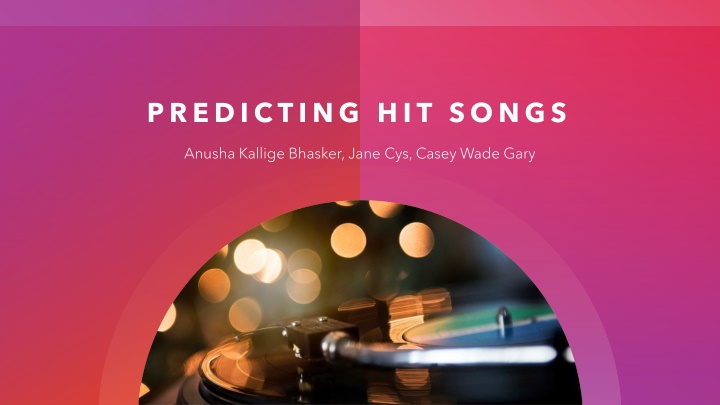
Predicting Hit Songs: Data Analysis on Song Attributes
Explore how data analysis is used to predict hit songs by analyzing song attributes from a dataset focusing on music from the 1990s. The project involves logistic regression and principal component analysis to determine key predictors of song success.
Download Presentation

Please find below an Image/Link to download the presentation.
The content on the website is provided AS IS for your information and personal use only. It may not be sold, licensed, or shared on other websites without obtaining consent from the author. If you encounter any issues during the download, it is possible that the publisher has removed the file from their server.
You are allowed to download the files provided on this website for personal or commercial use, subject to the condition that they are used lawfully. All files are the property of their respective owners.
The content on the website is provided AS IS for your information and personal use only. It may not be sold, licensed, or shared on other websites without obtaining consent from the author.
E N D
Presentation Transcript
PREDICTING HIT SONGS Anusha Kallige Bhasker, Jane Cys, Casey Wade Gary
Sample Footer Text BUSINESS PROBLEM AND DESCRIPTION The music industry had an annual revenue of $25.9 billion in 2021. We will predict which attributes of a particular song can be used to determine whether it will be a hit or a flop. Project Objectives Determine which song attributes will predict whether a song becomes a hit. Determine which song attributes might predict whether a song will be a flop. 2
Sample Footer Text The dataset focused on songs from the 1990s, as identified via a Spotify Web API, and included 5,521 observations. It was obtained from Kaggle.com. The dataset had 19 musical attributes 3 categorical variables and 16 continuous variables. DATA D E S C R I P T I O N The target variable (which is named target) is binary hit and a 0 indicates a flop binary; a 1 indicates a Categorical Variables Categorical Variables Acousticness Instrumentalness Liveness Valence Tempo Duration_ms Time_signature Chorus_hit Sections Track Artist Uri Danceability Energy Key Loudness Mode Speechiness 3
Sample Footer Text DATA PREPARATION Clean data set. No values missing and all data appeared as expected. Histograms were created to look at patterns in individual variables. Out of 5,520 overall observations only 10 outliers were identified across all variables. We left them in the model as such a small number was unlikely to cause significant impact. 4
Sample Footer Text Model 1 LOGISTIC REGRESSION Our logistic regression model showed strong predictability with 9 of 13 predictor variables having a p-value of less than .0001. Three more predictors had p-values below our alpha of .05 so 12 total continuous variables were included in our Final Logistic Model. This Final Logistic model had an RSquare value of .387 and correctly predicted 2,344 of 2,760 hit songs, yielding an Accuracy rate of 80%, a Sensitivity of 84%, and a Specificity of 75%. 5
Sample Footer Text Model 2 Slide 1 PRINCIPAL COMPONENT ANALYSIS All continuous variables in the dataset were used to conduct the Principal Component Analysis and break the dataset up into predictive components. Eigenvalue of the first PC was 3.1929 and explains 22% of the data variation. Eigenvalue of the second PC was 1.7880 and explains just over 10% of the data variation. The top 10 components combined accounted for only 58% of the data variance so PCA did not offer a simplification of the model over the logistic regression model in this case. We saved the top 10 components to the dataset for our use in regression. 6
Sample Footer Text After running logistic regression with all 10 components we attempted to refine the PCA model by removing the lowest performing component, PCA 5. Model 2 Slide 2 PRINCIPAL COMPONENT ANALYSIS The RSquare value for this PCA model was .3268 or only 32% of variance predicted compared with an RSquare of .387 for the final Logistic Regression model. The PCA model identified 1,948 of 2,760 hit songs, yielding an Accuracy rate of 77%, a Sensitivity of 70%, and a Specificity of 84%. 7
Sample Footer Text The decision tree had 24 decision points to predict whether a song is a hit or not. Model 3 The model had an R-square value of 0.465 on the training set, which indicates it explains 46.5% of the variability in the target variable. DECISION TREE According to the analysis, the feature with the highest contribution to predicting hit songs is "instrumentalness" with a G^2 value of 1031.11553 and a portion of 0.3595. The ROC is the same for training and validation data and shows the model has good predictive value. 8
MODEL COMPARISON Model Name Model Name Logistic Regression Principal Component Analysis Decision Tree R Square R Square 0.387 0.326 0.465 9
For the purpose of identifying hit songs we select the Decision Treemodel with it s high overall Accuracy and particular 90% Sensitivity for picking hits. CONCLUSIONS For identifying flops or non-hits the PCA model proved to have the highest Specificity (6% higher than the DT model). To operationalize we would recommend a combination method with both models making independent predictions for hits and flops and a final prediction based on those results. In general, the most valuable predictors of a hit song in our dataset were danceability, acousticness, and instrumenatlness. 10






















